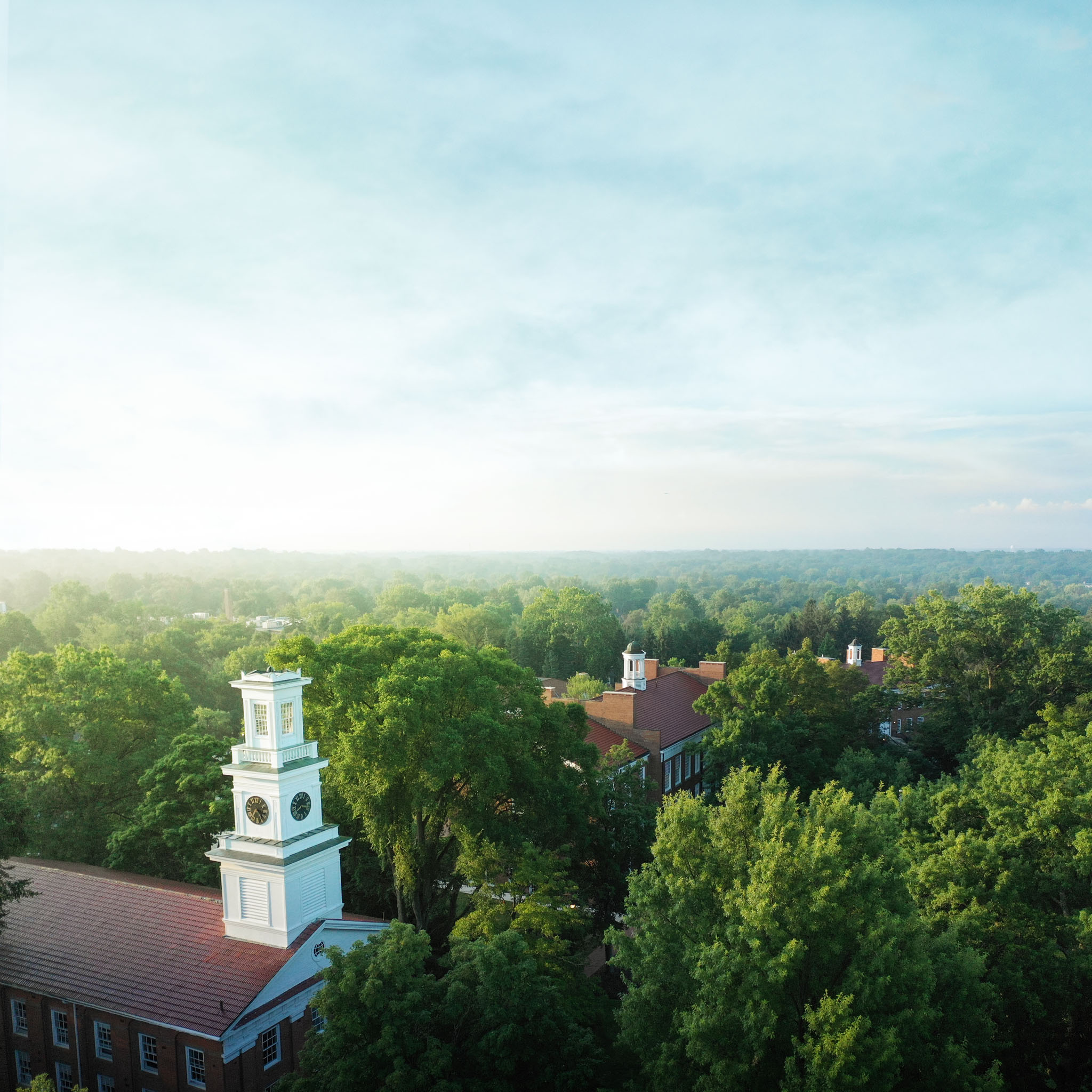
Today WRA welcomed John Yang ’75 back to campus for — if not a traditional Chapel talk, then a Chapel conversation. (Fitting actually, for a journalist.) Named this year’s Knight Fellow after the honor’s inception in his graduation year, Yang is among the school’s most known alumni, an acclaimed journalist currently with PBS NewsHour who has worked for the country’s most prestigious print and broadcast news outlets since he graduated from WRA, then Wesleyan University.
Yang was the first speaker in the school’s Bicentennial Speakers Series, following the launch of Bicentennial events earlier this week during the total solar eclipse. Yang is truly a Pioneer, with poise and intellect matching Midwestern politeness (he grew up in the tiny town of Chillicothe, OH). Yet, like the best reporters, he is tenacious, having covered conflicts around the world with such empathy and impact that he admits there were occasions where PTSD forced him to pull out of a war-riddled region.
Social Sciences Department faculty member and John W. Hallowell Chair in Philosophy and Ethics Dr. Lisabeth Robinson (Doc Rob) provided the introduction and a retrospective on 1975 — the fall of Saigon; the energy crisis; the premiere of Saturday Night Live; cultural phenomena like pet rocks and the Rubik’s Cube. So many topics piqued John’s interest as a student, and his curiosity, and ability to write well, led him to his decorated career, a story in its own right.
Doc Rob welcomed Yang to the stage in a Q&A format, which showed Yang’s compelling candor and allowed him to be interviewed by Reserve students, a welcome break from always asking all the questions. Below are excerpts from the conversation.
When did you know you would get into journalism?
I’m the type of guy who thinks if I can do something, everyone can. I was captivated by Watergate. I always wondered what was happening behind the scenes. I liked to break news, to be the first one running into the room telling something.
In what area do you think your reporting has had the most impact?
A story I did for the NewsHour about a prison inmate in Missouri who had been incarcerated for more than half his life despite solid evidence he did not do it. He was ultimately released from prison; the night he was released I got very emotional. I found being able to report on this very fulfilling.
You have done a lot of reporting on WWII veterans — do you feel an emotional connection?
I essentially feel like I’m a storyteller. I just did another story on WWII – when everyone went off to war, there were a lot of manufacturing jobs to be done. Women flocked into the factories by the million — they were Rosie the Riveters. This past week, Rosies were honored, thirty of them, on Capitol Hill. We interviewed the organizer, who is now 98 years old. She said she was motivated to work because Hitler said America would be easy to defeat because women were soft. She said, “I think we sent Hitler a message.”
How do you go about the research process — where do you get your information and ideas?
[Story ideas] often [come from] producers, who focus on specific areas, bringing our attention to issues or people, encouraging the team to cover or write about a topic. We get a lot of information from different sources; we call them characters, [as though] we’re making a little movie. We get characters from advocacy groups, or a lot of times from colleagues.
When gathering information on traumatic events, do you try to get the most raw reactions or are you trying not to re-traumatize people?
Because I like telling stories about people, I always want to talk to them the way I would want to be talked to in the same situation. I get to meet people who suffer more than I can imagine suffering. I always try to be gentle with people — I make it clear that I appreciate them trusting us with their story. I approach them in a thoughtful, kind and humane way.
How do you take care of yourself when covering heartbreaking stories?
I left my post in the Middle East because I had PTSD. I can remember forcing myself to go back out to cover a story. I had to tell myself, “If you feel this way, if you can’t do this anymore, stop.” I now turn down assignments that will put me into those places; the story of Michael Brown, the young man shot in Ferguson, Missouri in 2014…I was sitting in the satellite truck writing my piece for the next morning, and by the time I got out, the atmosphere had completely changed with a much angrier crowd. It was difficult to get back, and it took me a while to find my way out safely. I called my boss and said, “I have to leave.”
How did it feel becoming part of the story when you volunteered for COVID vaccination trials?
Friends and colleagues were thanking me for “taking this risk.” I actually did it to get the vaccine early! I was surprised at the attention. Working in newspapers, I was not the story, the story was what was happening around me. It took me a while in TV to get comfortable putting myself out there.
What do you see as the biggest impact of COVID on our generation?
I think we don’t know yet. I think about the youngest people who came into this world totally isolated. It has affected education; there was learning loss. It has changed the way we work; hybrid work is here. I think there are a lot of changes that we will discover as the generations go on. I had to learn a whole new way to do my job; going out and meeting people and seeing things was what sparked me, energized my writing and energized my storytelling. All of a sudden I was dealing with people at my dining room table over Skype.
How should medical institutions train staff in terms of diversity?
I did a story on neonatal healthcare — [studying] the death rate for newborns. There was a great program fighting it in Cincinnati. I met a lot of mothers, and I noticed the black women all said that if the doctors were white, they always discounted the pain of black patients. I was shocked to learn from a white doctor I spoke with that they were taught in med school that the pain threshold of black people is higher.
Do you feel you give voices to the voiceless?
A lot of the stories I do, do that. I have mixed feelings about this. When I was at NBC, I would do stories on a person and before the story was over, the switchboard would be getting calls of “how can I help?” I thought, “There are a lot of other people out there who had the same problems; how could they be helped?” This happened a lot in the refugee camps I covered, kids would follow you. You would want to help the person right next to you, but there were so many others who needed help. This is a dilemma for me.
What can be done through social media and the public to call attention to the plight of migrant workers and does the attention do any good?
I always tweet out what stories I’m going to be doing that night, as does PBS. It is a never ending amazement to me the haters on social media; even motherhood and apple pie will get a nasty reply. But the good thing about social media is the access it provides to multiple voices, sources.
What has changed over the years in the business with news consumption and social media?
The multitude of news sources is the biggest thing — cable, streaming, web sites. You can go to whatever source reinforces your idea; that someone will affirm that the assumption you have is right. I think this is a challenge the media hasn’t quite figured out.
How has reporting of Native American stories changed over the last decade?
PBS does hidden histories of unsung characters. When covering the eclipse, we had a community reporter in Oklahoma sharing the history of rich storytelling and tradition with regards to the solar eclipse. I think we, and other media outlets, are a lot more sensitive to these narratives and perspectives.
How do you feel attitudes toward police have changed?
More questions are being asked; I did a segment recently about the number of people who have died when officers are administering “non-lethal force.” There is more attention, and we are more sensitive.
What would you say to a young person wanting to pursue journalism?
Try it!
What have been the most challenging and joyful things as a journalist?
There were physical challenges — covering the Israeli Palestinian dispute; once we were leaving Gaza to drive to the Israeli checkpoint and missiles were fired alongside of us to reinforce the fact they wanted us to leave. With the Micheal Brown story, I interviewed as many people as I could find; then I read the FBI report, which contradicted everything I heard in my eyewitness accounts. There have been many challenges. Still, it has been a lot of fun and gratifying, too; like the prisoner who was released; people who are suffering and finally getting benefits; covering George W. Bush in the press pool and seeing the Air Force One Hangar.
+++
Western Reserve Academy is proud to count John Yang ’75 among our esteemed alumni and as our Knight Fellow and first Bicentennial Speaker. His remarkable journey from WRA to the national stage is a testament to his dedication and talent in the field. As recipients of his storytelling, we are not only informed but also inspired to engage with the issues that shape our society.





















